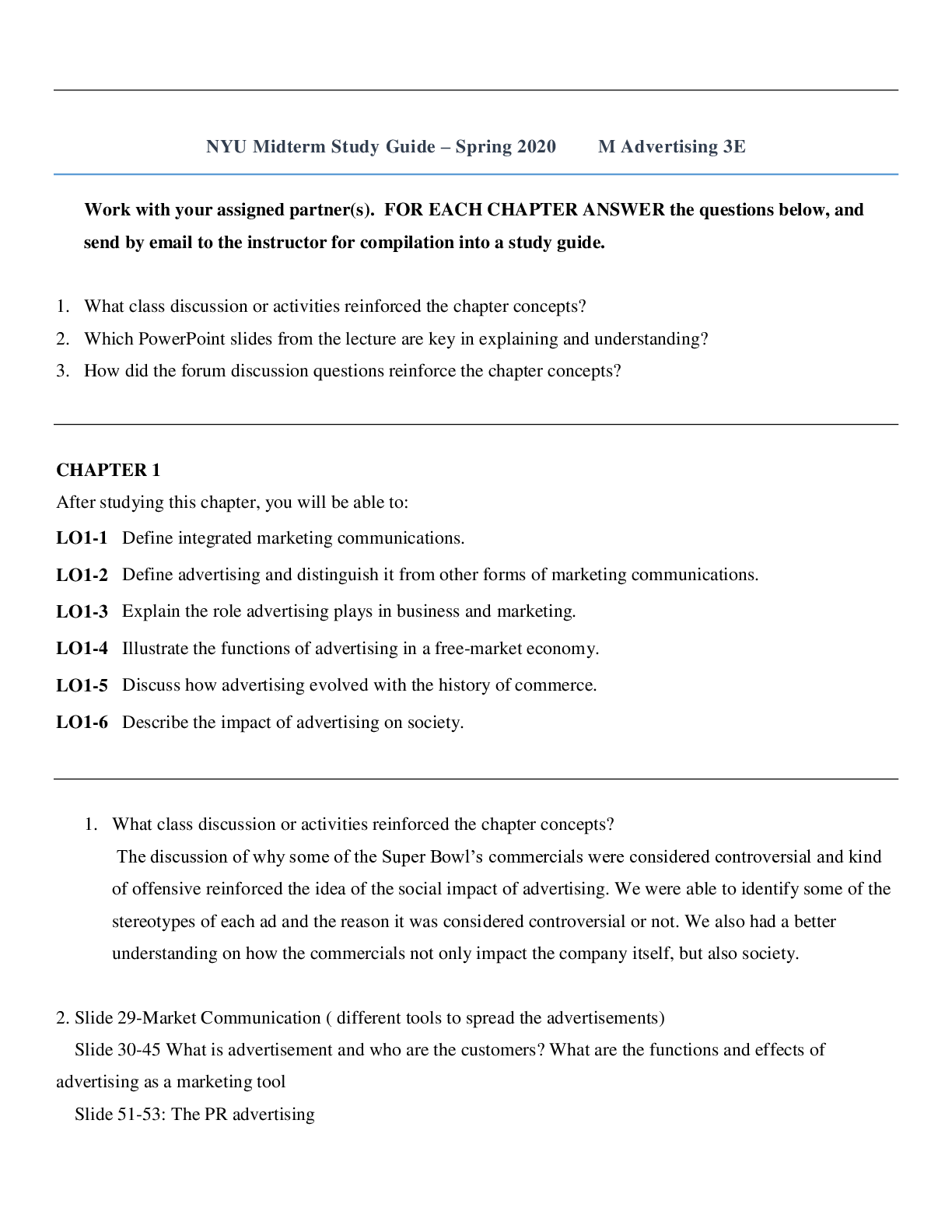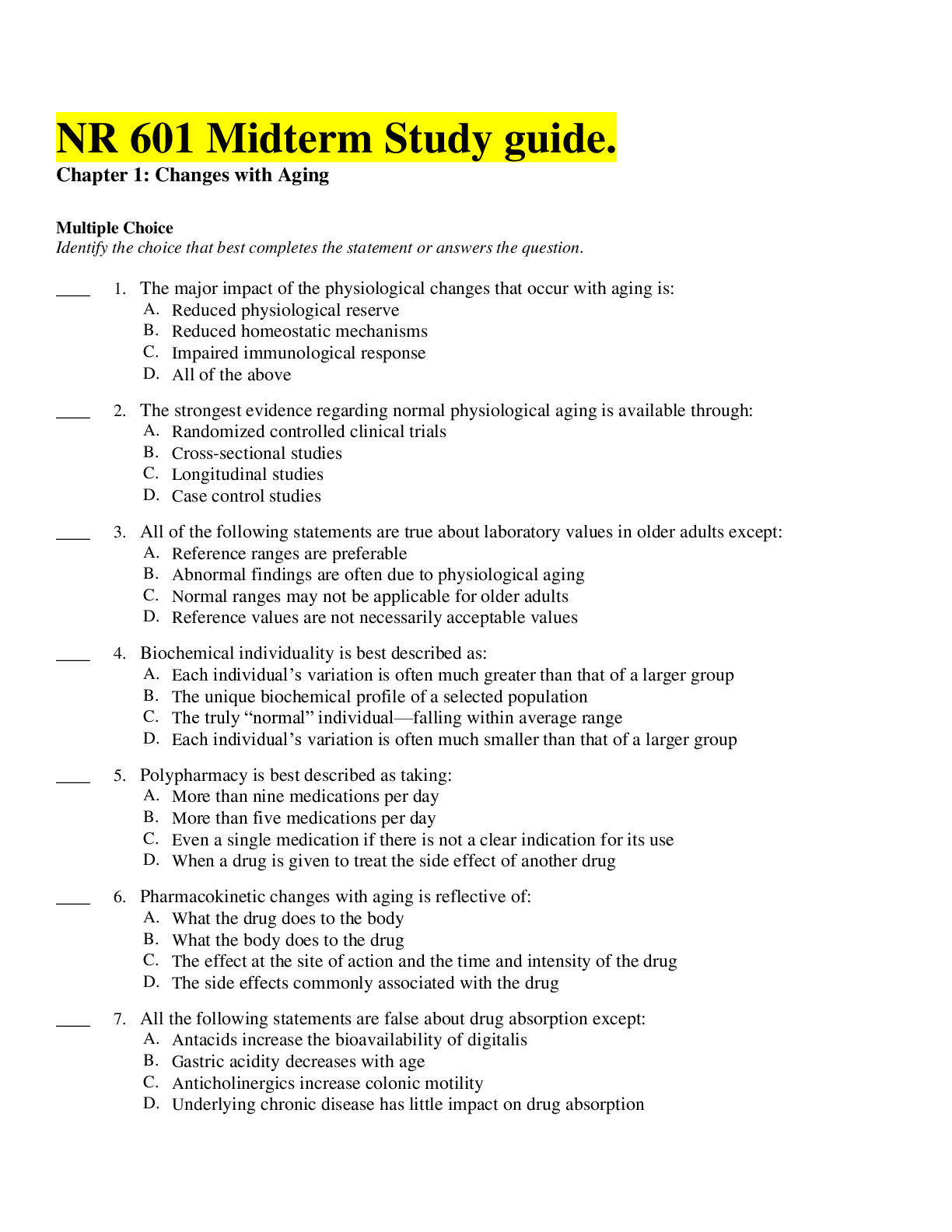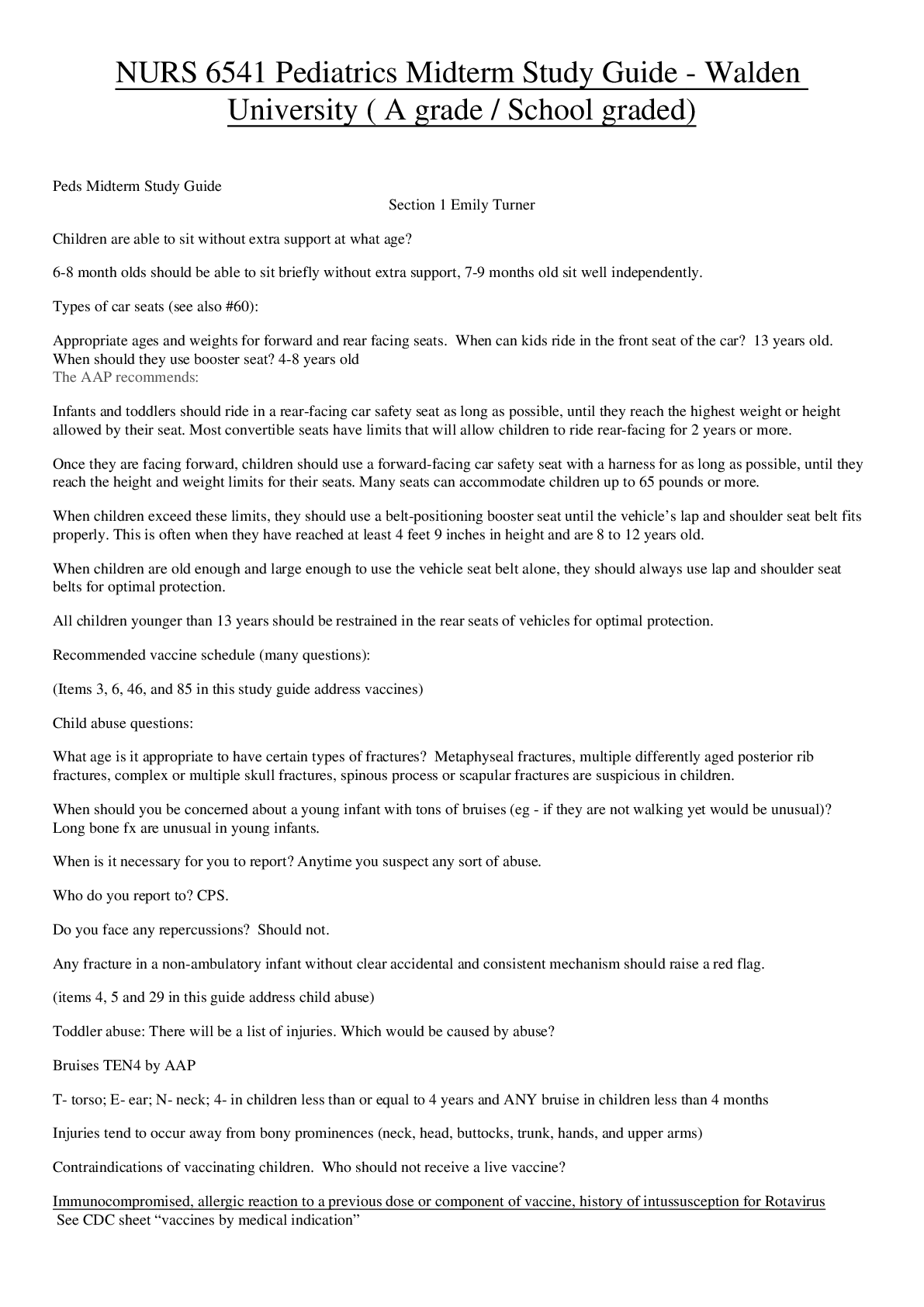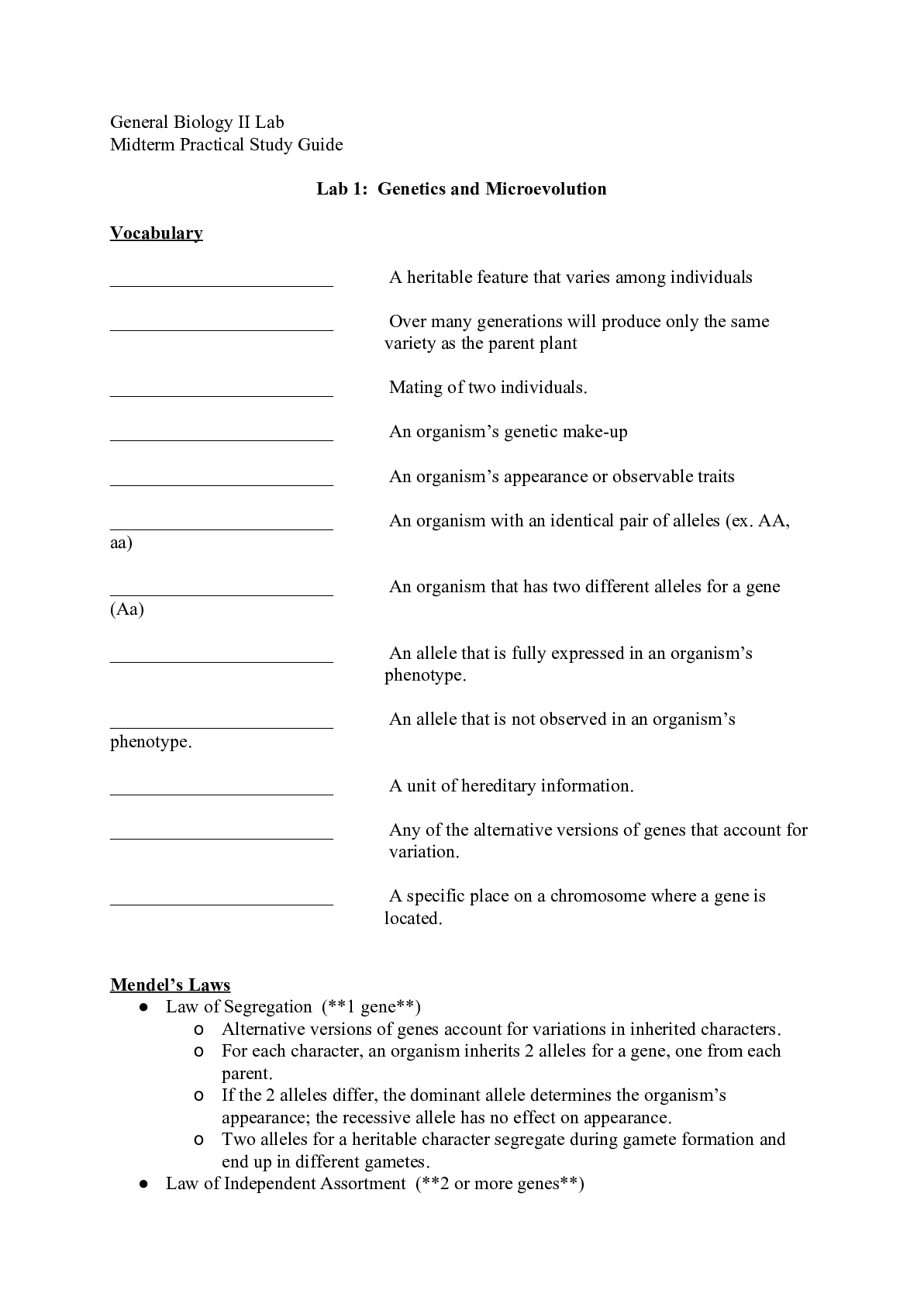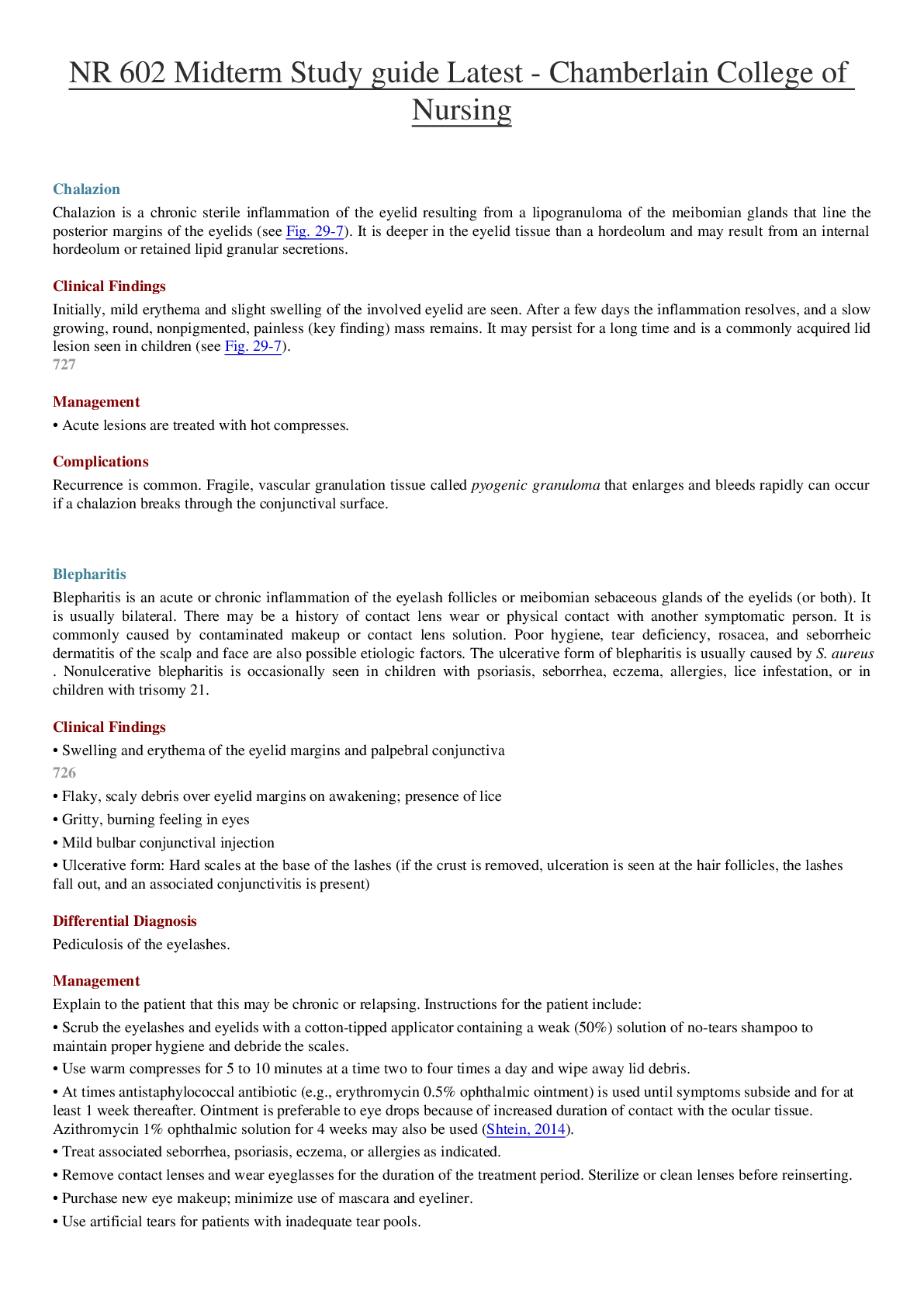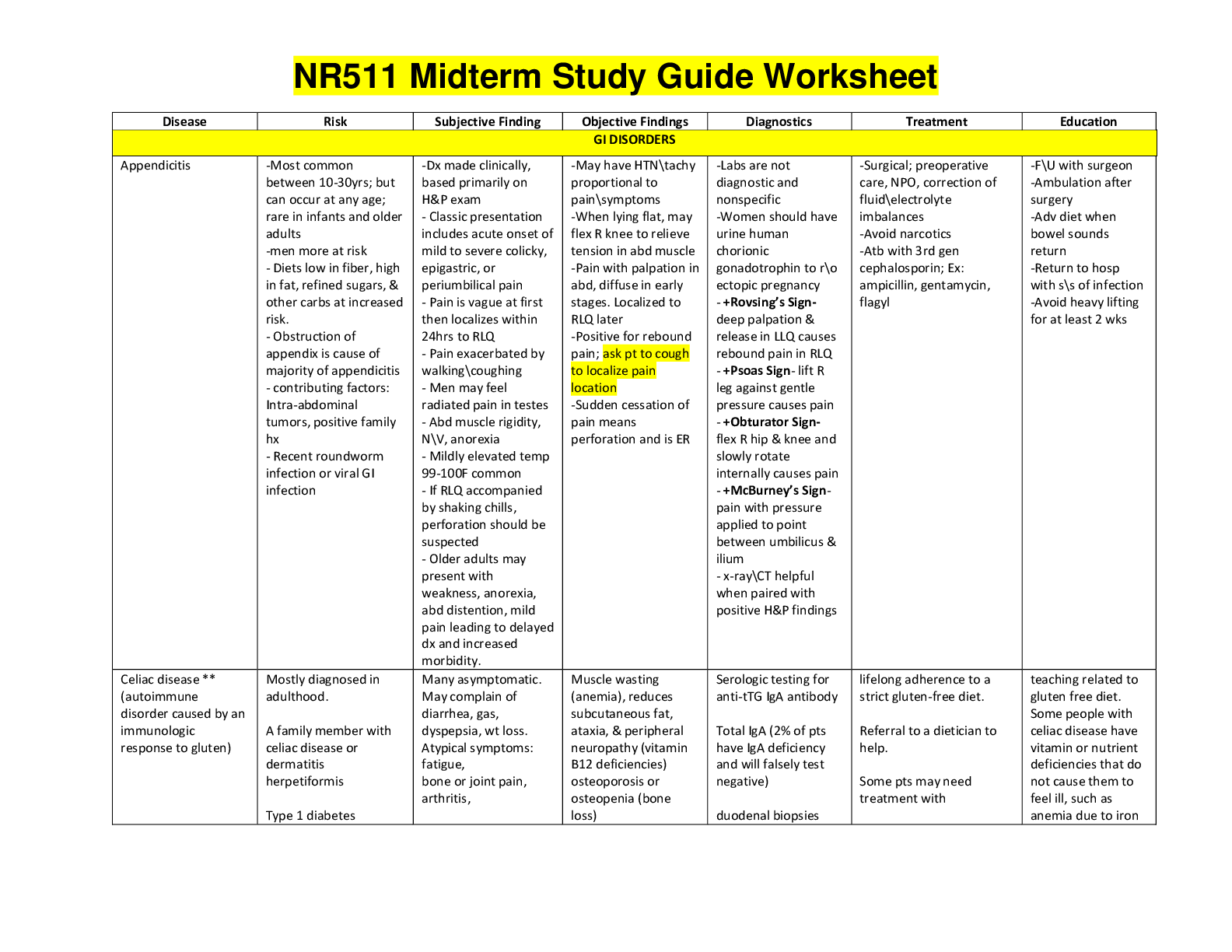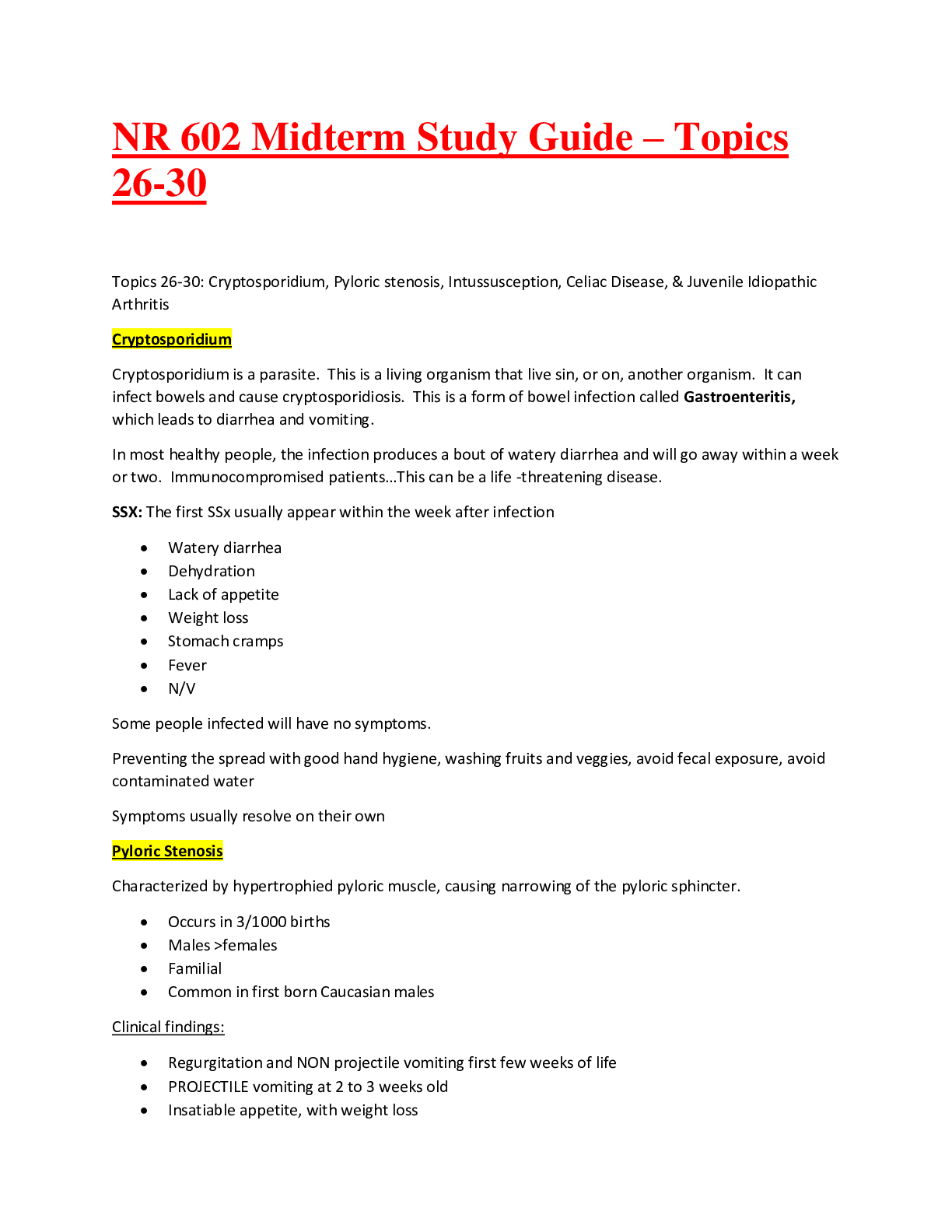*NURSING > STUDY GUIDE > NR 511 MIDTERM STUDY GUIDE – WEEKLY TOPICS WITH ANSWERS (All)
NR 511 MIDTERM STUDY GUIDE – WEEKLY TOPICS WITH ANSWERS
Document Content and Description Below
NR 511 MIDTERM STUDY GUIDE – WEEKLY TOPICS WITH ANSWERS Week One • Define diagnostic reasoning. o Reflective thinking because the process involves questioning one's thinking to determine if all... possible avenues have been explored and if the conclusions that are being drawn are based on evidence. Seen as a kind of critical thinking. • Identify subjective & objective data. SUBJECTIVE Anything the patient tells you or complains of regarding their symptoms, Chief complaint, HPI, ROS OBJECTIVE Anything YOU can see, touch, feel, hear, or smell as part of your exam, Includes lab data, diagnostic test results, etc. • Identify the components of the HPI. Specifically related to the chief complaint only, Detailed breakdown of CC, OLDCARTS • Develop an appropriate differential. List of possible diagnoses in order of priority., Confirm or r/o hypotheses; screen for conditions; monitor progress of a chronic condition • Accurately describe why every procedure code must have a corresponding diagnosis code. Diagnosis code explains the necessity of the procedure code., Insurance won't pay if they don't correspond. • Identify the three components required in determining an outpatient, office visit E&M code. Plan of service, Type of service, Patient status • Describe the differences between medical billing and medical coding. Medical billing: process of submitting and following up on claims made to a payer in order to receive payment for medical services rendered by a healthcare provider Medical coding: the use of codes to communicate with payers about which procedures were performed and why. • Compare and contrast the two coding classification systems that are currently used in the U.S. healthcare system. ICD: International classification of disease codes are used to provide payer info on necessity of visit or procedure performed. Shorthand for pt's dx. CPT: common procedural terminology codes offer the official procedural coding rules and guidelines required when reporting medical services and procedures performed by physician and non-physician providers. Must have corresponding ICD. • Discuss how specificity, sensitivity, and predictive value contribute to the usefulness of diagnostic data. • Specificity: ability of a test to correctly detect a specific condition. If a pt has a condition but test is negative, it is a false negative. If pt does NOT have condition but test is positive, it is false positive. Sensitivity: test that has few false negatives. Ability of a test to correctly identify a specific condition when it is present. The higher the sensitivity, the lesser the likelihood of a false negative. Predictive value: The likelihood that the pt actually has the condition and is, in part, dependent upon the prevalence of the condition in the population. If a condition is highly likely, the positive result would be more accurate. Diagnostic tests can be used to confirm or rule out hypotheses. Diagnostic tests may be used to screen for conditions. Diagnostic tests may be used to monitor the progress in managing a chronic condition. • Discuss the elements that need to be considered when developing a plan. Pt's preferences and actions, Research evidence, Clinical state/circumstances, Clinical expertise • Describe the components of medical decision making in E&M coding. o Risk, data, diagnosis, The more time and consideration involved in dealing with a pt, the higher the reimbursement from the payer., Documentation must reflect MDM • Correctly order the E&M office visit codes based on complexity from least to most complex. • New pt: 1. Minimal/RN visit: 99201 2. Problem focused: 99202 3. Expanded problem focused: 99203 4. Detailed: 99204 5. Comprehensive: 99205 Established pt: 1. Minimal/RN visit: 99211 2. Problem focused: 99212 3. Expanded problem focused: 99213 4. Detailed: 99214 5. Comprehensive: 99215 • Define the components of a SOAP note. o S: subjective (what the pt tells you) CC HPI PMH Fam Hx Social Hx ROS O: objective (what you can see, hear, feel on exam) Physical findings Vital signs General survey HEENT Etc... A: assessment Global assessment of pt including differentials in order from most to least likely Combination of subjective and objective info List of dx addressed and billed for at the visit P: plan What you will Rx When to come back Diagnostic tests Pt education • Discuss a minimum of three purposes of the written history and physical in relation to the importance of documentation. o Important reference document that gives concise info about the pt's hx and exam findings Outlines a plan for addressing issues that prompted the visit. Info should be presented in a logical fashion that prominently features all data relevant to the pt's condition., Is a means of communicating info to all providers involved in pt's care, Is a medical-legal document Is essential in order to accurately code and bill for services • Correctly identify a patient as new or established given the historical information. o Pt status: whether or not pt is new or established., New: has not received professional service from provider in same group within past 3 years., Established: has received professional service from provider in same group in last 3 years. • Correctly identify the most specific ICD-10 code with the information given • Explain what a "well rounded" clinical experience means. Includes seeing kids from birth through young adult visits for well child and acute visits, as well as adults for wellness or acute/routine visits., Seeing a variety of pt's, including 15% of peds and 15% of women's health of total time in the program. • Discuss the maximum number of hours that time can be spent "rounding" in a facility. No more than 25% of total practicum hours in the program • Discuss nine things that must be documented when inputting data into clinical encounter logs. Date of service Age Gender and ethnicity Visit E&M code CC Procedures Tests performed/ordered Dx Level of involvement • Explain each part of the acronym the SNAPPS presentation. S: summarize (present pt's H&P findings) N: narrow (based on H&P, narrow down top 2-3 differentials) A: analyze (compare/contrast H&P findings for each differential and narrow it down to most likely one) P: probe (ask preceptor questions of anything you are unsure of) P: plan (come up with specific management plan) S: Self-directed learning (opportunity to investigate more about topics you are uncertain of) Week 2 • Identify the most common type of pathogen responsible for acute gastroenteritis. Viral (can be viral, bacterial, or parasitic), usually norovirus • Identify when stool studies are warranted In pts with severe or prolonged diarrhea, fever >38.5C, bloody stools, stools +leukocytes/occult blood • Describe the difference between Irritable Bowel Disease (IBS) and Inflammatory Bowel Disorder (IBD). o IBS: disorder of bowel function (as opposed to being due to an anatomic abnormality). Changes in bowel habits (diarrhea, constipation, abd pain, bloating, rectal urgency w/diarrhea). Symptoms fall into two categories: abd pain/altered bowel habits, and painless diarrhea. Usually pain is LLQ. PE: normal except for tenderness in colon. Labs: CBC, ESR. Most other labs and radiology/scopes are normal. Dx made on careful H&P. May be associated with nonintestinal (extra-intestinal) symptoms (sexual function difficulty, muscle aches/pains, fatigue, fibromyalgia, HAs, back pain, urinary symptoms). Not associate with serious medical consequences. Not a risk factor for other serious GI dz's. Does not put extra stress on other organs. , Overall prognosis is excellent. , Major problem: changes quality of life. Treatment: based on symptom pattern. May include diet, education, pharm (for mod-severe pt's)/other supportive interventions. Usually focuses on lifestyle, diet, and stress reduction. NO PROVEN TREATMENT! Antidiarrheals: use temporarily, reserve for severe. Loperamide (Imodium) or diphenoxylate (Lomotil) 2.5-5mg q6h usually works. Constipation: high fiber diet, hydration, exercise, bulking agents. If these don't work, intermittent use of stimulant laxatives (lactulose or mag hydroxide); don't use long-term! Linzess (linaclotide), Trulance (plecanatide), and Amitiza (lubiprostone): newer for constipation, work locally on apical membrane of GI tract to increase intestinal fluid secretion and improve fecal transit. Abd pain: dicloclymine (Bentyl), hyoscyamine (avoid anticholinergics in glaucoma and BPH, especially in elderly). TCAs and SSRIs can relieve symptoms in some pt's.Can be managed by PCP, but if not responsive to tx, refer to GI. IBD: chronic immunological dz that manifests in intestinal inflammation. UC and Crohn's are most common. UC: mucosal surface of colon is inflamed, resulting in friability, erosions, bleeding. Usually occurs in rectosigmoid area, but can involve entire colon. Ulcers form in eroded tissue, abscesses form in crypts, become necrotic and ulcerate, mucosa thickens/swells, narrowing lumen. Pt's are at risk for perforation. Symptoms: bleeding, cramping, urge to defecate. Stools are watery diarrhea with blood/mucus. Fecal leuks almost always present in active UC. Tenderness usually in LLQ or across entire abd. Crohn's: inflammation extends deeper into intestinal wall. Can involve all or any layer of bowel wall and any portion of GI tract from mouth to anus. Characteristic segmental presentation of dz'd bowel separated by areas of normal mucosa ("skipped lesions"). With progression, fibrosis thickens bowel wall, narrowing lumen, leading to obstructions, fistulas, ulcerations. Pt's are at greater risk for colorectal cancer. Most common symptoms: cramping, fever, anorexia, wt loss, spasms, flatulance, RLQ pain/mass, bloody/mucus/pus stools. Symptoms increase with stress, after meals. 50% of pt's have perianal involvement (anal/perianal fissures). Inflammation can lead to bleeding, fever, increased WBC, diarrhea, cramping. Abnormalities can be seen on cross-sectional imaging or colonscopy. No single explanation for IBD. Theory: viral, bacterial, or allergic process initially inflames small or large intestine, results in antibody development which chronically attack intestine, leading to inflammation. Possible genetic predisposition. Dx made by H&P correlated with symptoms, must exclude infectious cause for colitis. Primary dx tools: sigmoidoscopy, colonoscopy, barium enema w/small bowel follow-through, CT. Tx is very complex, managed by GI. Drugs: 5-aminosalicylic acid agents have been used for >50yrs, but have shown to be of little value in CD; still used as first attempt for UC. Antidiarrheals w/caution (constipation). Don't use in acute UC or if toxic megacolon. Corticosteroids used when 5-ASA not working. If corticosteroids don't work, use immunomodulators (azathioprine, methotrexate, 6-mercaptopurine), but can cause bone marrow suppression and infection. Newer class: anti-TNF (biologic response modifiers) for mod-severe dz. Remicade (infliximab), Humira (adalimumab), Entyvio (vedolizumab); can increase risk of infection. • Discuss two common Inflammatory Bowel Diseases.< Ulcerative colitis, Crohn's disease • Describe the characteristics of acute diverticulitis Subjective: S/S of infection (fever, chills, tachycardia), Localized pain LLQ, Anorexia, n/v, If fistula present, additional s/s will be present associated w/affected organ (dysuria, pneumaturia, hematachzia, frank rectal bleeding, etc) Objective: Tenderness in LLQ, Maybe firm, fixed mass at area of diverticuli, Maybe rebound tenderness w/involuntary guarding/rigidity, Hypoactive bowel sounds initially, then hyperactive if obstructive process present, Rectal tenderness, +occult blood • Discuss how the diagnosis of diverticulitis is made Diagnostics: Mild-moderate leukocytosis, Possibly decreased hgb/hct r/t rectal bleeding, Bladder fistula: urine will have increased WBC/RBC, culture may be +, If peritonitis, blood culture should be done (for bacteremia), Abd XR: perforation, peritonitis, ileus, obstruction, CT may be needed to confirm • Discuss colon cancer screening recommendations relative to certain populations. o Age 50 or older: initial scope at 50yo, then every 10yrs. If at increased/high risk of colorectal cancer, start screening earlier (i.e. age 40) and be screened more often based on findings., African Americans: Starts screening at age 40-45. • Describe an intervention for a patient with gastroenteritis. Fluid repletion (PO if possible, pedialyte; IVF for more severe dehydration), Nutrition • Discuss an appropriate treatment for prophylaxis or treatment of traveler's diarrhea. Trimethoprim-sulfamethoxazole (Bactrim DS) 1 tab BID x3days, Cipro 500mg, Norfloxacin (Noroxin) 400mg Ofloxacin (Floxin) 300mg • Identify at least one effective treatment for Irritable Bowel Syndrome (IBS). Diet (avoid lactose, caffeine, legumes, artificial sweeteners; eat low-fat diet with increased protein, high fiber, bulk-producing agents, 64oz water daily), Lifestyle modification, Exercise, Stress reduction Pharm (for moderate-severe symptoms only): antidiarrheals (imodium, lomotil), laxatives (lactulose, mag hydroxide), antispasmodics (dicyclomine, hyoscyamine), tricyclic antidepressants; avoid anticholinergics with glaucoma and BPH pts. • Identify at least one prescription medication for the treatment of chronic constipation. Linzess (linaclotide), Trulance (plecanatide), Amitiza (lubiprostone), Lactulose, Mag hydroxide • Describe the component of the H&P that should be done for a patient with abdominal pain OLDCARTS Upper abd pain: ask about chronic/recurring and related symptoms (bloating, fullness, heartburn, n/v) Lower abd pain: if acute, is pain sharp, intermittent continuous? If chronic, is there a change in bowel habits (alternating diarrhea/constipation)? Radiation? .........continued [Show More]
Last updated: 2 years ago
Preview 1 out of 17 pages
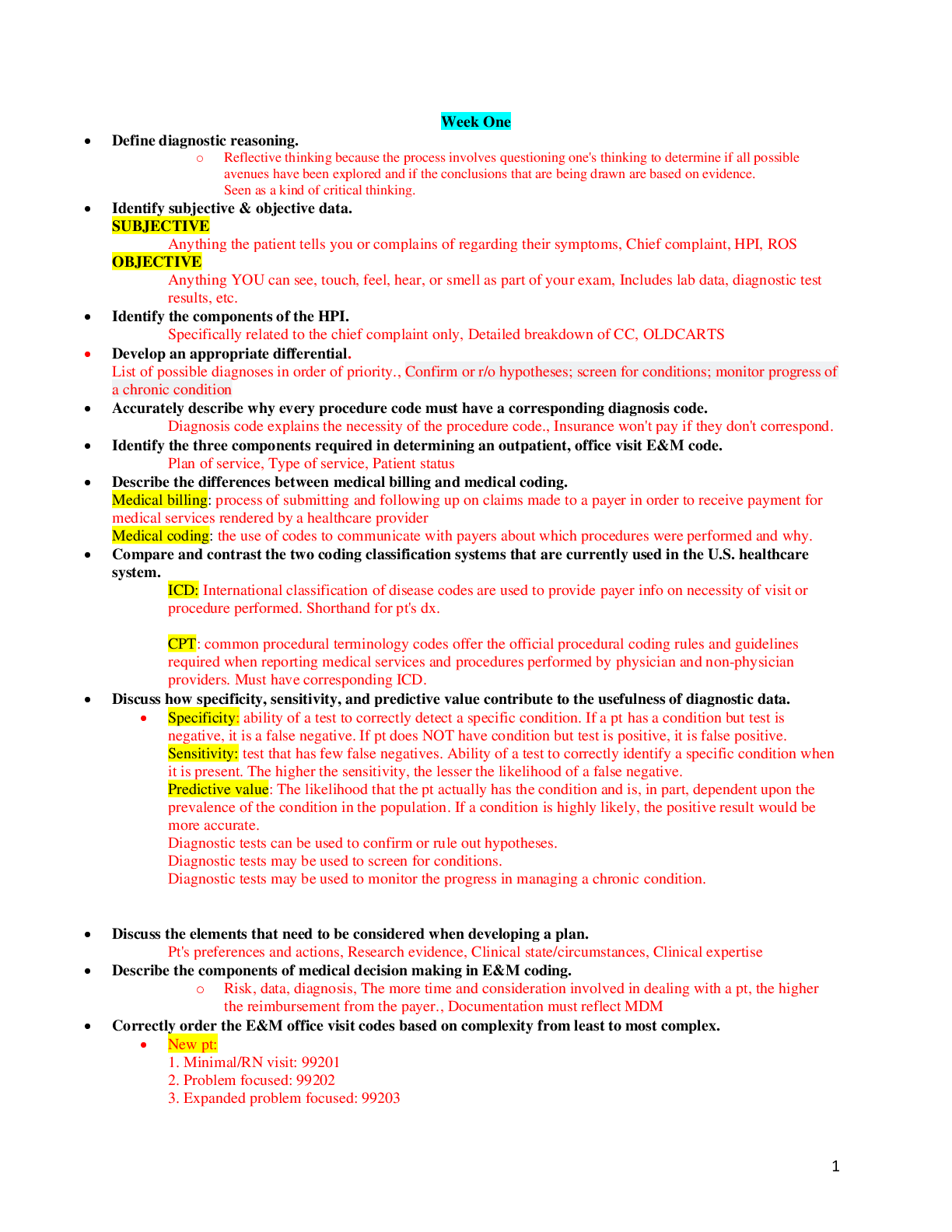
Buy this document to get the full access instantly
Instant Download Access after purchase
Buy NowInstant download
We Accept:

Reviews( 0 )
$15.50
Can't find what you want? Try our AI powered Search
Document information
Connected school, study & course
About the document
Uploaded On
Feb 09, 2021
Number of pages
17
Written in
Additional information
This document has been written for:
Uploaded
Feb 09, 2021
Downloads
0
Views
55













